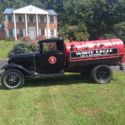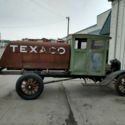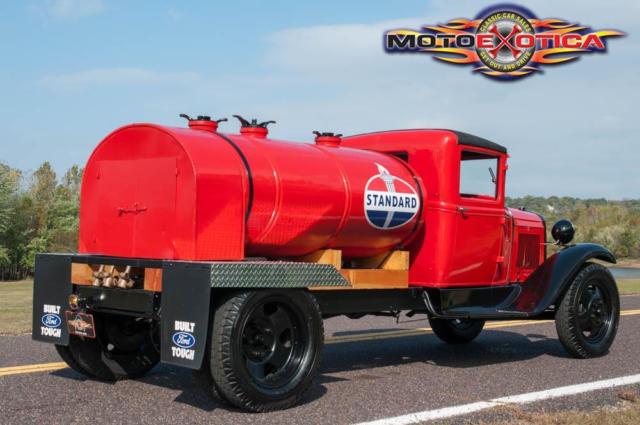1931 Ford Model AA Dually Tanker
- Price:
- Location: Saint Louis, Missouri, United States
- Condition: Used
- Make: Ford
- Model: Other Pickups
- SubModel: Dually Tanker Truck
- Type: Dually Tanker Truck
- Trim: Dually Tanker Truck
- Year: 1931
- Mileage: 77,529
- VIN: A4546421
- Color: Red
- Engine size: 201 CID Inline 4 Cylinder
- Power options: --
- Fuel: Gasoline
- Transmission: Manual
- Drive type: Dually Tanker Truck
- Interior color: Black
- Options: --
- Vehicle Title: Clear
1931 Ford Other Pickups Dually Tanker Truck Description
Ideal parade or show truck candidateRed exterior and restored, black Lebaron Bonney interior
201 CID inline four-cylinder engine
Four-speed manual transmission
New parts - brakes, battery wiring, tires, horn, tail light, top wood and top cover
Tank is for show only and cannot be used/filled
Looking for a rolling conversation piece in your town's next parade, festival or holiday event? MotoeXotica Classic Cars is pleased to present this fun 1931 Ford Model AA Tanker tru...ck.
This tanker has many new parts - seven new tires, a Lebaron Bonney interior, brakes, battery wiring, horn, tail light, top wood and top covering. The main tank is for show only and cannot be used. Also, truck does not come with any jerry cans.
With its shiny red paint and Standard Oil livery, it really stands out. The paint and minimal trim are in great shape, as are the glass panels and lights, all crack- and haze-free. The truck rolls on 20-inch, five-slot metal disc wheels used in 1930 and part of 1931 and they are within Firestone Gum-Dipped tires, size 6.50-20 with 6.00-20 spares. The dual wheels were used for a variety of body styles, including dump trucks, tow trucks, tankers, fire trucks and flatbed stake trucks.
All of this truck's body panels are straight and in good order, as is the engine bay and the bumpers. Inside, the restored Lebaron Bonney interior looks good and fits the truck's original service mission. The bench seat, headliner, dashboard, four-spoke steering wheel, door skins, mirrors and shift lever all look right at home. This truck is a radio delete model and there is only a driver's side windshield wiper. The Model AA was based on a chassis similar to that of the Model A Ford, except it was substantially larger and heavier to accommodate the work for which this truck was designed. The Model AA was available with a number of options. Two wheelbases were available, 131.5 inches and 157 inches.
the same 201 CID inline four-cylinder engine used in the Model A, it featured an updraft carburetor, six-volt generator, two-blade fan, mechanical water and oil pumps, electric starter and four-row radiator. All of these features were identical to the Model A except for the radiator. The engine could also be started with a hand crank inserted through a hole in the radiator shell, if necessary. The engine is linked to a four-speed manual gearbox with lower gearing than the Model A to provide more power to move loads. This lower gearing reduced the top speed of the truck when compared to the car. The transmission also featured a reverse lock-out on the shift knob that required a lever to be activated with the thumb to engage reverse. This was done to prevent accidental engagement of reverse while the truck was in motion.
The suspension of the AA Truck was similar to the A Car in the front end. A leaf spring is centered in the front 'A' frame over the front axle. Shock absorbers were available for the front end. The rear suspension differed from the car. The AA had leaf springs mounted to the chassis and shackled to the rear axle. The rear suspension did not have shocks.
The controls in the Model AA are entirely mechanical, except the windshield wipers in later models. The brakes are mechanical and the truck has four oversized drums. The mechanical system is a pull lever system that applies the force from the pedal to a pivot that pulls the brake rods that expand the brakes in the drums. The brake light is activated when the brake pedal is pushed. The brakes are proportioned more toward the rear drums. The parking brake is a chrome lever on the floor with a release button on the top. The windshield wipers started as hand operated and later models were powered by vacuum diverted from the intake manifold. The horn button is mounted in the middle of the steering wheel assembly. Controls for the lights are also incorporated into the steering assembly. The switch was a three-stop switch for parking lights, headlights and high-beams. The tail-light lens colors on the AA underwent several changes during the production run. Two levers are mounted on the steering column to adjust the engine. The left lever controls the manual advance of the timing. Adjusting the timing of the engine changes the time that a spark will occur in the combustion chamber and those changes affect the performance of the engine. The right lever is a manual control for the throttle. The throttle can be adjusted to ease the shifting of the transmission and the idling speed of the engine. Underneath the dash on the right side is the choke rod. The choke can adjust the flow of fuel from the carburetor into the engine. Turning the knob on the choke rod clockwise closes the fuel flow, leaning out the engine; turning the knob counterclockwise opens the fuel flow to the engine.
The gauge cluster includes three basic gauges. The cluster is in a diamond formation, with the start key and pop-out locking switch is on the left point. The top of the cluster holds the gas gauge, which directly connects into the gas tank, behind the dashboard. The right point holds the amp gauge, which shows the charge rate of the generator. The bottom of the dash holds the speedometer and odometer. Additional gauges can be mounted below the cluster if desired.
As the Model T car and TT truck became obsolete and needed to be replaced, Henry Ford began initial designs on the Model A and Model AA in 1926. Basic chassis layout was done rapidly and mechanical development was moved forward quickly. Body design and style was developed and then outsourced to various body manufacturers, including Briggs and Murray. The designs of the Model A shared parts and materials with the Model AA Ford, notably the body, engine and interior. The AA usually received plainer interiors than their car counterparts. The Model AA followed similar design changes to the Model A during the AA's four years in production, often delayed anywhere from three to nine months. The mechanical changes and upgrades were done during production of the vehicles. Body changes that occurred between 1929 and 1930 were also integrated into AA production, but leftover parts were used longer in the heavy commercial trucks.
This truck is currently located at our facility in St. Louis, Missouri. Current mileage on the odometer shows 77,529 miles. It is sold as is, where is, on a clean and clear, mileage exempt title.
VIN: A4546421
Note: Please see full terms and conditions listed below that pertain to the purchase of any said vehicle, thank you.
More Ford classic cars for sale
 1931 Ford Model AA Dually Tanker, Inline 4, 4-spd manual, LOTS OF NEW PARTS
1931 Ford Model AA Dually Tanker, Inline 4, 4-spd manual, LOTS OF NEW PARTS
 1931 Ford Model AA Tanker 0
1931 Ford Model AA Tanker 0
 1931 Ford Model A Tribute Mobil Tanker
1931 Ford Model A Tribute Mobil Tanker
 1931 Ford Model AA Fuel Tanker Truck
1931 Ford Model AA Fuel Tanker Truck
 1931 Ford Model AA Tanker 0 Black Truck 3.3L
1931 Ford Model AA Tanker 0 Black Truck 3.3L
 1931 AA Ford Tanker Truck
1931 AA Ford Tanker Truck
 1931 FORD AA TANKER TRUCK; 2 DOOR
1931 FORD AA TANKER TRUCK; 2 DOOR
 Model TT tanker Philips 66 Ford
Model TT tanker Philips 66 Ford
 1924 ford model tt tanker truck
1924 ford model tt tanker truck
 1930 FORD MODEL AA SINCLAIR FUEL TANKER
1930 FORD MODEL AA SINCLAIR FUEL TANKER
 1931 Ford Model AA Dually Tanker, Inline 4, 4-spd manual, LOTS OF NEW PARTS
1931 Ford Model AA Dually Tanker, Inline 4, 4-spd manual, LOTS OF NEW PARTS
Year: 1931
Mileage: 77,529
Mileage: 77,529
 1931 Ford Model AA Tanker 0
1931 Ford Model AA Tanker 0
Year: 1931
 1931 Ford Model A Tribute Mobil Tanker
1931 Ford Model A Tribute Mobil Tanker
Year: 1931
 1931 Ford Model AA Fuel Tanker Truck
1931 Ford Model AA Fuel Tanker Truck
Year: 1931
Mileage: 99999
Mileage: 99999
 1931 Ford Model AA Tanker 0 Black Truck 3.3L
1931 Ford Model AA Tanker 0 Black Truck 3.3L
Year: 1931
 1931 AA Ford Tanker Truck
1931 AA Ford Tanker Truck
Year: 1931
Mileage: 58
Mileage: 58
 1931 FORD AA TANKER TRUCK; 2 DOOR
1931 FORD AA TANKER TRUCK; 2 DOOR
Year: 1931
Mileage: 1,000
Mileage: 1,000
 Model TT tanker Philips 66 Ford
Model TT tanker Philips 66 Ford
Year: 1924
Mileage: N/A
Mileage: N/A
 1924 ford model tt tanker truck
1924 ford model tt tanker truck
Year: 1924
Mileage: 500
Mileage: 500
 1930 FORD MODEL AA SINCLAIR FUEL TANKER
1930 FORD MODEL AA SINCLAIR FUEL TANKER
Year: 1930
Mileage: 100
Mileage: 100












